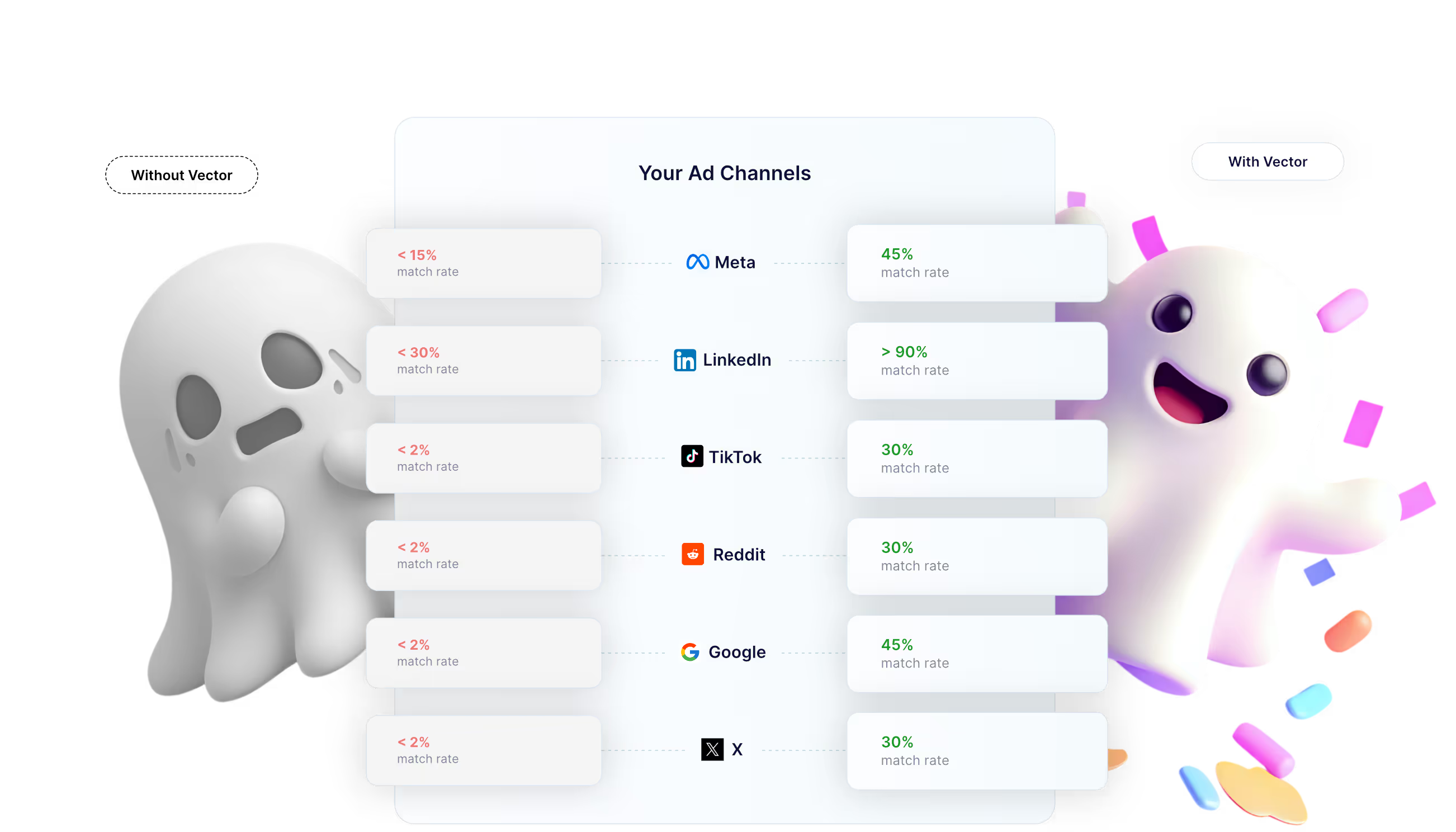Signal-based marketing, no magic required

Every spooky season, marketers try to brew signal-based campaigns without Vector and the results are straight out of a Sanderson sister spell gone wrong.

Low match rates.
Vanishing audiences.
Budgets turning to dust.
They’ve got intent data, enrichment tools, maybe even a shiny CDP, but when it’s time to reach real people with ads, the cauldron goes cold.
So what’s missing from the potion?

The secret ingredient: identity
Signals on their own are like wisps of smoke....interesting, but impossible to act on.
Marketers keep waving their hands over data dashboards hoping it’ll take shape but come on, it’s just a bunch of hocus pocus.

Vector adds the grounding element: a “persona graph” that connects those intent and behavioral signals to actual ad identifiers (MAIDs, HEMs, cookies, and more).
Quick explainer
- Persona graph: the bridge between “someone showed intent” and “someone you can actually reach.” Vector links behavior to identity: name, title, company, and device.
- MAID (Mobile Ad ID): anonymous ID tied to a mobile device, used by ad platforms for targeting.
- HEM (Hashed Email): privacy-safe version of an email address that ad networks can still match.
- Cookies: browser trackers that tie sessions to people.
That’s how Vector turns ghostly data into living audiences.

Building an CBM program around signals
You don’t have to sprinkle intent data on top of your CBM programs, you can build them around signals.
Vector is the vessel for a signal-based marketing approach, and it’s signal-agnostic:
you can use Vector’s first-party signals and bring your own from tools like 6sense, Bombora, or your CRM.
.png)
Once they’re in Vector, we unify them at the contact level, so you can trigger plays, sync ad audiences, or alert sales based on what people are actually doing.
The real magic: your ICP
Even the best signals need direction.

That’s where your ICP comes in.
Inside Vector, you define your ICP once: job titles, seniority, industries, or target accounts and it filters through everything you do:
- Visitor feeds highlight high-fit contacts.
- Ad audiences exclude the noise.
- Sales alerts go only to relevant reps.
- Reports prove influence on the right accounts.
Start broad, then tighten as you learn what converts.
The sharper your ICP, the stronger your signal strategy.

Product spotlight: Ad Reveal
With Vector’s Ad Reveal, you can see who’s clicking your ads at the contact level.

But instead of flooding your sales team with every click, you can filter for high-value contacts aka those matching your ICP, on your target-account list, or tied to open opportunities in your CRM.
How to run the play:
- Go to Segments → Create New Segment.
- Select Visitors on my site as your trigger.
- Add Advertising Filters and select platforms (Google, Meta, LinkedIn, etc.).
- Apply ICP, Target Account, or Open Opportunity filters.
- Choose Sales as your destination and send alerts via CRM or Slack.
- Include ad details for context so reps can personalize outreach.
When a qualified contact clicks your ad, Vector pushes the info to sales in real time:
“Jane Smith, Director of IT at Acme Corp, clicked on your Cloud Security ad.”
Minutes later, your rep sends a tailored follow-up like this:

Expected results:
- Sales works fewer, higher-value contacts.
- Faster engagement on warm signals.
- Ad spend is directly tied to pipeline.
Using ad platforms with Vector
First, make sure your Vector Pixel is installed on every landing page you’re driving traffic to that’s what powers contact-level tracking and de-anonymization.

Typical match rates
Platform Match Rates:
LinkedIn: 65–85%
Google Ads: 35–50%
Meta: 35–45%
Reddit / X: up to 30%
Pro tip: professional, U.S.-based, recently active contacts perform best.
Native integrations (automagic syncing)
- Google Ads
- X (Twitter)
- Meta
Just hit Connect on your segment and Vector syncs audiences daily.
For other platforms like Pinterest, TikTok, and Bing, you can schedule automatic CSV exports delivered weekly.
💡 Best practices
- Keep ICP and lists fresh.
- Name audiences clearly (“High Intent – Week 1”).
- Check the “Last Synced” timestamp in Vector.
Cross-platform retargeting magic
Meta is great for awareness, but not conversion.
Vector customers take Meta ad clicks who meet their ICP and retarget them on Google, where purchase intent is higher. No wasted impressions on non-fit visitors.
With contact-level identity and omni-channel syncs, you can:
- Run “always-on” Google audiences.
- Use intent-based LinkedIn ads for education.
- Track engagement across Meta, Reddit, and X.
- Retarget high-fit contacts everywhere else.
Don’t change your creative, just change who sees it.
Signal-based marketing, no black magic required
Signal-based marketing isn’t sorcery.

It’s strategy powered by identity, precision, and timing.
Vector gives you:
- the cauldron (contact-level data)
- the catalyst (signals from anywhere)
- and the wand (activation across ads, alerts, and reports).
When you connect signals to real people, align them to your ICP, and activate them across channels, your marketing stops chasing ghosts and starts driving growth.
So if your campaigns have been feeling a little lifeless lately... it might be time to put a signal on them.
Ad targeting
doesn't have to be
a guessing game.
Turn your contact-level insights into ready-to-run ad audiences.


